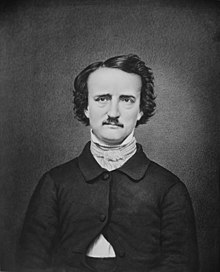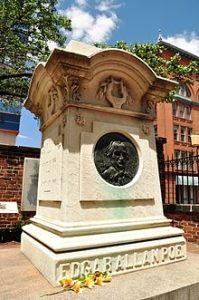Edgar Allan Poe was a pioneer of modernism and decadence, and his writings bore the hallmark of unending sorrow. Poe is most known for penning classic dark stories with a mystical undertone. Through his short stories, philosophical fiction, and rationalizations, the author, who aims to challenge readers’ narrow perspectives, conducted creative research on the workings of the human mind. One direct result of the prose writer’s skill is the development of the detective and psychological thriller genres.
The greatest minds of the 19th century, such as the symbolist writers Konstantin Balmont and Charles Baudelaire, appreciated Poe’s expertise in striking a balance between the beauty and horror of death, as well as the reality of the mental pain he depicted in his writings. Poe was known for his “damned poet” persona. Even during Edgar’s lifetime, people who were not devoid of metaphorical thought claimed that the creator’s name, veiled in the romantic sufferer’s aura, would go down in the annals of world literature.
Early Life and Adolescence
Born in Boston, the capital city of Massachusetts, on January 19, 1809, the future spiritual mentor of Howard Lovecraft was born in the northeastern United States. Elizabeth Arnold Hopkins and David Poe, the poet’s parents, were both exceptionally talented artists. His father was a law student from Baltimore who favored the acting career over the lucrative legal field, and his mother was an English actress who immigrated to the United States. The family also reared two other children: a younger sister named Rosalie (1810–1874) and an elder brother named William Henry Leonard (1807–1831), according to the history of the literary arabesque genius.
Edgar’s father abandoned the family when he was just a year old. About what happened to the man after that, nothing is known for sure. The poet’s mother passed away from consumption in 1811. Officially, all three kids were placed with adoptive parents. Edgar found himself in the household of John Allan and his wife Frances, co-owners of a trading enterprise that sold cotton and tobacco. The spouses were well-respected and powerful in Richmond’s elite circles, where they resided before to their departure for England.
The kid, who had never experienced warmth or affection, found the much-needed care he lacked in the Allan household. Frances was a devoted mother to Edgar, taking great pride in raising him as her own. John did not feel the same joy as his wife. The father could not comprehend why his girlfriend thought adoption was preferable to giving birth naturally. In addition to spoiling his adopted son, the businessman mistreated him. Edgar used to get anything he wanted when he was a kid. His parents had no boundaries on their wants and desires at that time.
Edgar was sent to school at the age of five after shown an early aptitude for learning. The Allan family departed for Great Britain in 1815 in search of employment. Poe’s instructors there were the severe weather and equally severe English educational traditions. He was a robust, intelligent teenager when he returned to America. The future poet’s education in the Old World made it easy for him to get into a nearby institution in 1820. Poe was negatively impacted by the family’s financial struggles after returning to their own country as well as the recurring arguments between Frances and John.
The once-jovial child became more and more reclusive in his room, choosing the quiet company of books over the boisterous companionship of his contemporaries. Edgar’s passion in poetry developed throughout his time of deliberate solitude. The young man’s new obsession was beyond Allan’s comprehension. Without imagination, the father thought that working hard in the family business would be the finest job for Edgar Poe, allowing him to eventually earn a stake in the company. When his adopted kid and his guardian couldn’t agree on anything, John would always remind him that his life depended on the one who was watching over him.
Poe was deeply in love with Jane Stanard, his friend’s mother, while he was a college student. All night long, the dignified woman and the ardent young man could only communicate through backstage meetings and talks. Edgar thereafter dedicated the poem “Helena” to his beloved; it was the name the writer gave to his chosen one. Poe felt joyful for the first time in his life. It’s true that the writer didn’t experience the joys of shared love for very long.
Jane got meningitis in 1824, went insane, and passed away. Edgar, devastated, started having nightmares. The young man was very startled when he perceived someone’s cold palm resting on his face in the utter darkness of the night. A healthy imagination constantly conjured up the dreadful visage of some unknown beast rising toward him in the early morning dusk.
Biographers claim that this is when the writer first started exhibiting signs of his mental illness, which eventually developed into persecution mania, regular periods of apathy, and suicidal ideas. The writer’s stepfather became one of Richmond’s wealthiest men in the spring of 1825 after inheriting $750,000 from his late uncle. Poe made the decision to seize the chance and convinced Allan to cover the cost of his University of Virginia schooling. John, on the other hand, made the decision to conserve money since he had grown avaricious with age. Rather than the $350 that was due, he gave the young man just $110.
Edgar arrived at the Thomas Jefferson-founded school and was immediately immersed in an unfamiliar, bourgeois setting. Poe attempted in vain to blend in with the affluent young men and ladies around him, but the handouts supplied by his guardian barely covered his rent. Edgar made his already unstable circumstances worse when he chose to play cards for money. Edgar’s creditors sent a large number of bills to John Allan in December 1826. The merchant arrived in Charlottesville in a horrible mood, telling his adopted son that his university epic—which had not yet truly begun—was gone.
Poe was unable to continue at the institution after the academic year ended on December 21, 1826, despite his evident academic success and pass marks on exams. The young poet was really upset at his humiliation. After another argument, Poe’s stepfather threw him out of the house, adding gasoline to the fire by accusing the former pupil of being irresponsible every day. Edgar made his home in the Court-House bar, where he continued to write epistolary letters to Allan, trying to work out their differences. Poe left the room of the den of vice after a few days and traveled to Norfolk and then Boston.
Books
By coincidence, the writer met Calvin Thomas, a young printer in his hometown, and he consented to produce Tamerlane, the writer’s first book of poems. The composition was released in 1827. Poe composed these masterpieces between the ages of 12 and 14, and he apologized to readers in the foreword for the crudeness of the works contained in the book.
Al Aaraaf, Tamerlane and Other Poems, the poet’s second poetry collection, was published in 1829. Poems, his third book, was published in April 1831 and contained previously unreleased poems (Israfel, Paean, Condemned City, To Helen, Sleeping). Edgar was able to compile his new poems into Stories, a stand-alone publication that year, thanks to The Raven’s early success in 1845.
It is important to note that Allan’s work has consistently placed the novella genre at its center. Several themes can be found in Poe’s novellas: science fiction (“The Extraordinary Adventure of a Certain Hans Pfaall”, “The Sphinx”, “The Balloon Story”), logical (“The Gold Bug”, “The Murder in the Rue Morgue”, “The Mystery of Marie Roget”, “The Purloined Letter”), humorous (“The Spectacles”, “Breathless”, “The Thousand and Second Tale of Scheherazade”), psychological (“The Black Cat,” “Ligeia”, “The Cask of Amontillado”, “The Oval Portrait”), and psychological (“The Black Cat”.
The author’s four logical works, featuring detective Auguste Dupin as the principal character, marked the beginning of the detective genre. Originating from Edgar Allan Poirot’s imagination, the detective became the model for three well-known bloodhounds: Sherlock Holmes, Hercule Poirot, and Miss Marple. Poe only revealed his actual personality to the public in poetry, despite the fact that it was his stories that first brought him fame. Edgar was able to build stronger relationships with readers through the use of poetry.
Individual life
The year the writer’s stepfather kicked him out of the house is when he met his first and only wife. Aunt Clemm gladly took Poe into her mansion in Baltimore after learning that her nephew had nowhere to dwell. That was when the amiable Virginia and the melancholy Edgar started to fall in love. The date of the wedding was September 12, 1835. There was no public wedding. At the time of the wedding, Edgar was 26 years old, and his chosen one was just 13 years old. The family of Mrs. Clemm opposed the marriage.
They felt that marrying a slacker to rob Virginia of her childhood was a very bad idea (poetic writing was not then regarded as a vocation for a worthy man). The older mother had a different perspective: she recognized Edgar was a genius right away and that her daughter would not find a better match.
Poe’s life was steered by Virginia, who encouraged him to produce exceptional works. The young woman tolerated the writer’s challenging nature as well as their family’s persistent poverty because she loved Eddie so much. It’s important to note that Edgar also had an odd dependence on his wife’s wellbeing and disposition. After Poe’s sweetheart passed away in January 1847 from TB, the author experienced a protracted depressive episode. The widower liked his work and other women’s embraces better than heavy cocktails. The only thing that made the creator forget the trauma he had to endure was booze.
Demise
On October 7, 1849, Edgar Allan Poe passed away in a Baltimore hospital. The author of the short story “The Frog” was admitted to the hospital on October 3, 1849, according to the physician who saw him in his final days. The writer was disoriented in time and place, wearing garments off of other people’s shoulders and unable to recall his own name or last name. The man was put in a room with barred windows after becoming insane. Even after spending a few days in the hospital, Poe never showed signs of recovery. He was suffering from convulsions and hallucinations; he also kept saying the name of a Reynolds, who was never identified, and he mentioned his late wife.
The poet passed away in the hospital after four days. Those were his final words, “Lord, receive my poor soul.” Every medical record, including the death certificate of Edgar Poe, vanished. The writer’s death was reported in the newspapers at the time as the result of a central nervous system inflammatory illness and brain sickness. These diagnoses were frequently applied to people who passed away from drinking in the 19th century. It is still unclear what exactly brought down the literary legend. On October 8 of that year, a small number of individuals accompanied the funeral procession. Poe was laid to rest in Westminster Cemetery in Baltimore, with a nameplate, a blanket, a cheap, handleless casket, and a pillow beneath his head.
The writer’s ashes were moved to a cemetery nearer the entryway on October 1, 1875. With money donated by readers of the writer’s work, a monument was also created and built. Poetry, rhyme, and story collections have preserved the hoaxer’s literary heritage. Plots for contemporary movies and television shows have been influenced by works such as “The Pit and the Pendulum,” “The Fall of the House of Usher,” “The Masque of the Red Death,” “Berenice,” “The Murders in the Rue Morgue,” and “Metzengerstein.”
